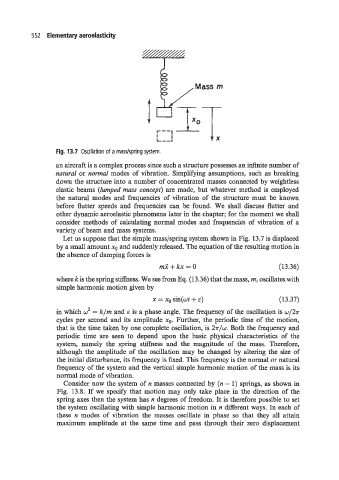Page 571 - Aircraft Stuctures for Engineering Student
P. 571
552 Elementary aeroelasticity
ass m
L--J -l
I ‘-1 -
Fig. 13.7 Oscillation of a masdspring system. X
an aircraft is a complex process since such a structure possesses an infinite number of
natural or normal modes of vibration. Simplifying assumptions, such as breaking
down the structure into a number of concentrated masses connected by weightless
elastic beams (lumped mass concept) are made, but whatever method is employed
the natural modes and frequencies of vibration of the structure must be known
before flutter speeds and frequencies can be found. We shall discuss flutter and
other dynamic aeroelastic phenomena later in the chapter; for the moment we shall
consider methods of calculating normal modes and frequencies of vibration of a
variety of beam and mass systems.
Let us suppose that the simple mass/spring system shown in Fig. 13.7 is displaced
by a small amount xo and suddenly released. The equation of the resulting motion in
the absence of damping forces is
mx+kx=O ( 13.36)
where k is the spring stiffness. We see from Eq. (13.36) that the mass, m, oscillates with
simple harmonic motion given by
x = xo sin(wt + E) (13.37)
in which 3 = k/m and E is a phase angle. The frequency of the oscillation is w/2~
cycles per second and its amplitude xo. Further, the periodic time of the motion,
that is the time taken by one complete oscillation, is ~K/w. Both the frequency and
periodic time are seen to depend upon the basic physical characteristics of the
system, namely the spring stiffness and the magnitude of the mass. Therefore,
although the amplitude of the oscillation may be changed by altering the size of
the initial disturbance, its frequency is ked. This frequency is the normal or natural
frequency of the system and the vertical simple harmonic motion of the mass is its
normal mode of vibration.
Consider now the system of n masses connected by (n - 1) springs, as shown in
Fig. 13.8. If we specify that motion may only take place in the direction of the
spring axes then the system has n degrees of freedom. It is therefore possible to set
the system oscillating with simple harmonic motion in n different ways. In each of
these n modes of vibration the masses oscillate in phase so that they all attain
maximum amplitude at the same time and pass through their zero displacement

